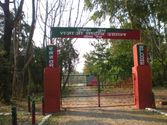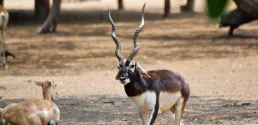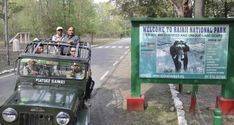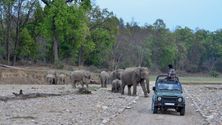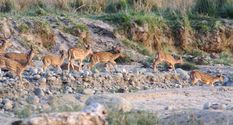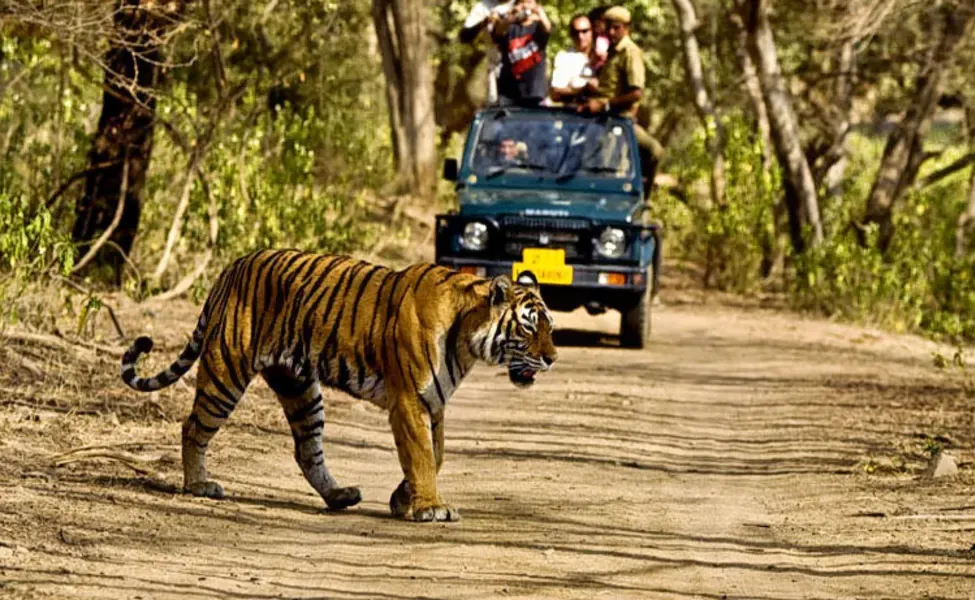
- Places to visit
- Raja Ji National Park
Raja Ji National Park
Explore the lush landscapes and diverse wildlife of Rajaji National Park, a haven of nature's wonder.
- Get Directions
- Enquire Now
- Share
- Leave a review
- Improve Details
Raja Ji National Park highlights
- Location: Raja Ji National Park is situated in the northern Indian state of Uttarakhand and covers an area of 975 sq. km .
- Biodiversity: The park is home to a diverse range of flora and fauna, including tigers, elephants, leopards, and various species of birds.
- Forest types: Raja Ji National Park is characterized by a mixture of different forest types, including sal forests, mixed deciduous forests, and bamboo forests.
- Wildlife conservation: The park is an important center for wildlife conservation, with efforts underway to protect and conserve its rich biodiversity.
- Trekking: Raja Ji National Park is also a popular destination for trekking, with visitors often taking guided treks to explore the park's forests and wildlife.
- Wildlife safaris: Wildlife safaris are also offered in the park, allowing visitors to see its wildlife and experience its beauty up close.
- Scenic surroundings: The park is surrounded by beautiful landscapes and scenic views, making it an ideal destination for nature lovers and adventure seekers.
- Environmental conservation: Efforts are underway to preserve the natural beauty and ecosystem of Raja Ji National Park, with measures being taken to reduce human impact and protect the area's flora and fauna.
Raja Ji National Park overview
Surrounding the mighty Shivalik mountain ranges, Rajaji National Park is famous for its abundantly rich flora and fauna. And it is the perfect holiday retreat for wildlife enthusiasts and nature lovers. This national park is renown for its diverse wildlife, especially elephants and tigers. It has recently acquired Tiger Reserve status from the Indian Government.
The Chilla and Ganges Rivers continue to divide the Rajaji and Motichur sanctuaries from the Chilla Wildlife Sanctuary to the southeast despite their proximity. While the Shiwalik Range is divided by several valleys that convey water and descend from the central ridge, the Rajaji and Motichur wildlife sanctuaries are located south and north of that ridge, respectively. These streams are dry for the majority of the year, but during the monsoon they turn into furious cascades, providing the perfect environment for animals to reproduce.
The Chilla and Ganges Rivers continue to divide the Rajaji and Motichur sanctuaries from the Chilla Wildlife Sanctuary to the southeast despite their proximity. While the Shiwalik Range is divided by several valleys that convey water and descend from the central ridge, the Rajaji and Motichur wildlife sanctuaries are located south and north of that ridge, respectively. These streams are dry for the majority of the year, but during the monsoon they turn into furious cascades, providing the perfect environment for animals to reproduce.
Ideal time to visit Raja Ji national park
Since the national park is closed during the other months, November to June is the best time to visit. Furthermore, keep in mind that April to June, although being a little hot, is the best period to see the most wildlife.
Raja Ji National Park historical background
In 1983, Rajaji National Park was created by merging three wildlife preserves with the names Motichur (1964), Rajaji (1948), and Chilla (1977), which were all named after the eminent statesman and freedom fighter Sri C. Rajgopalachariya, who served as the country's first governor general after independence.
Further, historical records state that Sri C. Rajgopalachariya was led to the Shooting Block in the Dehradun Forest Division during his 1948 visit to Dehradun as Governor General. But after observing the area's stunning splendour, he decided against hunting and suggested that it should be protected because of its physical beauty. Rajaji Wildlife Sanctuary was eventually created as a result of it.
Things to do at Raja Ji National Park
- Safari in Rajaji National Park is enjoyable: Along with safaris into the jungle , the park provides additional activities. Jeeps are used mostly for these. Two safaris are offered , one in the morning and the other in the afternoon. Morning hours are from 7 to 10 am , while afternoon hours are from 2:30 to 5:30 Sunrise and sunset determine the timing of the safari.
- Watch unique bird species: The Rajaji National Park has a greater variety of bird species due to the wide plains in the foothills between the central and western Himalayas. Some notable bird species found here are Greater Scaup, Great Hornbill, White-naped Woodpecker, Black-bellied Tern, Northern Goshawk, Yellow-billed Blue Magpie, and Snowy-browed Flycatcher.
- Visit the well-known tiger park: Visit the renowned tiger sanctuary while you are at Rajaji National Park. Over 50 different kinds of animals, including Asian elephants, tigers, jackals, black bear, and hyenas are among those that may be seen here.
A few good reasons to visit Raja Ji National Park
- After the well-known Jim Corbett National Park, Rajaji National Park is the second-best tiger national reserve park.
- a large, open, and geo-friendly environment with a total size of 820.20 square kilometres.
- Experience the amazing wildlife safari in an uncovered jeep.
- A vast array of vegetation and animals, as well as a wild stream hideaway.
Activities close to Raja Ji National Park
1.Discover the beautiful Chilla Barrage: It is a magnificent dam bridge on the Ganga near Dehradun and is commonly referred to as Pashulok Barrage. And to get there, you may travel beside the lovely Ganga Canal, giving you captivating views of the area. Additionally, the Chilli Barrage region produces power for Rajaji National Park as well as the whole Pauri Garhwal district.
2. Jhilmil Jheel is home to a wide variety of plants and animals: Nearby Rajaji National Park, Jhilmil Jheel is another another fun location to explore. Additionally, it is a forest reserve renowned for the rich diversity of its flora and wildlife. You can see some uncommon tiger, deer, leopard, and elephant species here as well.The migrating birds that visit this location also contribute their beautiful chirps to the atmosphere.
3. Enjoy rafting on the Ganges: Other thrilling activities at Rajaji National Park include canoeing and river rafting. On request, 3-hour rafting trips on the Ganges River's streams are provided over distances of up to 12 km. Additionally, this service is available in the national park's jungle lodges for INR 800 per person.
How to reach Raja ji national park
Places like Haridwar, Mussoorie, Rishikesh, Dehradun, and Saharanpur can reach the national park from there. These cities are still well connected to other Indian cities by air, train, and road connections. So you may easily organise a trip to park using any method you think is appropriate.
- By Rail: You may take a taxi or take a local bus to go to Rajaji National Park from the closest railway stations in Rishikesh (18 km), Haridwar (24 km), and Dehradun (56 km), respectively.
- By Air: Jolly Grant Airport in Dehradun is 35 kilometres from Rajaji National Park, and from there you may hire a taxi to go there.
- By Road: Major Indian towns like Dehradun, Haridwar, Rishikesh, and Delhi are well connected by road to Rajaji National Park. By hiring a private cab or using local transport services, you may easily get here.
Travel tips
- Numerous endangered plant and animal species may be found in the park. Be a responsible traveller and follow the instructions outlined by the forest authorities.
- Never bring any weapons or guns into park area.
- Keep a respectful distance from all animals and avoid getting too near.
- Bring extra water and a pair of binoculars for a better experience.
- It is highly forbidden to play loud music, chase, or tease the animals.
The Natural World
The national park's flora, which includes riverine vegetation, grasslands, scrubland, broadleaved deciduous woods, and pine forests, is situated between the Shivalik hills and the Indo-Gangetic plains. And the vast rainforests and vivid vegetation make it the ideal resting place for the species in this national park. Here is a quick summary of the local flora and fauna species:
- Local Flora Species:
Amaltas (Cassia fistula)
Rohini (Mallotus philippinensis)
Arjun (Terminalia arjuna)
Palash (Butea monosperma)
Shisham (Dalbergia sissoo)
Sal (Shorea robusta)
Sandan (Ougeinia Oojeinensis)
Khair (Acacia catechu)
Aonla (Emblica officinalis)
Baans (Dendrocalamus strictus)
Semul (Bombax ceiba)
Bel (Aegle Marmelos)
Kachnar (Bauhinia variegata)
Chamaror, (Ehretia laevis)
Ber (Ziziphus mauritiana)
Chilla (Casearia tomentosa) - Local Fauna Species:
The largest concentration of tigers and elephants may be found at Rajaji National Park, although other wild animal species include:
Bengal Tiger
Asian Elephant
Jungle Cat
Leopard
Himalayan Black Bear
Goral
Striped Hyena
Indian Hare
Sloth Bear
Jackal
Rhesus Macaque
King Cobra
Barking Deer
Sambhar
Wild Boar
Indian Langur
Indian Procupine
Python
Monitor Lizard
Places to visit in Rishikesh
Activities in Rishikesh
Cafes in Rishikesh
Backpacker Hostels in Rishikesh
Yoga Schools in Rishikesh
Events in Rishikesh
Religious Places in Rishikesh
Live Ganga Aarti
Explore the enchanting beauty of Rishikesh, where spirituality meets adventure amidst stunning landscapes & the sacred Ganges River.
Explore
ActivitiesPlace to VisitReligious Places Backpack HostelsCafes & RestaurantsYoga SchoolsEvents Copyright 2025 © Rishikesh.app | All rights reserved
